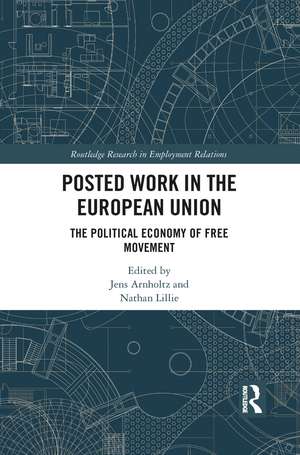Posted Work in the European Union: The Political Economy of Free Movement: Routledge Research in Employment Relations
Editat de Jens Arnholtz, Nathan Lillieen Limba Engleză Paperback – 30 iun 2021
The main objective of this book is to explore the dynamics of institutional change, by showing how trans- and supra-national dynamics affect European industrial relations systems. This volume will represent the "state of the art" in research on worker posting. It will also contribute to debates on European integration, social dumping, labour market dualization and precariousness and will be of value to those with an interest employment relations, law and regulation.
| Toate formatele și edițiile | Preț | Express |
|---|---|---|
| Paperback (1) | 383.68 lei 6-8 săpt. | |
| Taylor & Francis – 30 iun 2021 | 383.68 lei 6-8 săpt. | |
| Hardback (1) | 1000.27 lei 6-8 săpt. | |
| Taylor & Francis – 14 oct 2019 | 1000.27 lei 6-8 săpt. |
Din seria Routledge Research in Employment Relations
- 9%
 Preț: 934.96 lei
Preț: 934.96 lei -
 Preț: 231.55 lei
Preț: 231.55 lei -
 Preț: 416.22 lei
Preț: 416.22 lei -
 Preț: 414.91 lei
Preț: 414.91 lei -
 Preț: 414.32 lei
Preț: 414.32 lei - 12%
 Preț: 301.33 lei
Preț: 301.33 lei -
 Preț: 489.57 lei
Preț: 489.57 lei - 18%
 Preț: 1000.27 lei
Preț: 1000.27 lei - 12%
 Preț: 301.55 lei
Preț: 301.55 lei - 15%
 Preț: 293.39 lei
Preț: 293.39 lei - 18%
 Preț: 1221.12 lei
Preț: 1221.12 lei -
 Preț: 416.22 lei
Preț: 416.22 lei - 18%
 Preț: 1064.01 lei
Preț: 1064.01 lei -
 Preț: 489.26 lei
Preț: 489.26 lei -
 Preț: 428.40 lei
Preț: 428.40 lei -
 Preț: 416.22 lei
Preț: 416.22 lei - 12%
 Preț: 301.55 lei
Preț: 301.55 lei - 18%
 Preț: 1000.27 lei
Preț: 1000.27 lei - 26%
 Preț: 766.31 lei
Preț: 766.31 lei - 25%
 Preț: 824.40 lei
Preț: 824.40 lei - 28%
 Preț: 876.46 lei
Preț: 876.46 lei - 13%
 Preț: 294.77 lei
Preț: 294.77 lei -
 Preț: 485.07 lei
Preț: 485.07 lei - 15%
 Preț: 440.67 lei
Preț: 440.67 lei - 18%
 Preț: 1330.04 lei
Preț: 1330.04 lei - 26%
 Preț: 875.16 lei
Preț: 875.16 lei - 26%
 Preț: 765.62 lei
Preț: 765.62 lei - 15%
 Preț: 426.34 lei
Preț: 426.34 lei -
 Preț: 416.22 lei
Preț: 416.22 lei -
 Preț: 416.22 lei
Preț: 416.22 lei -
 Preț: 377.23 lei
Preț: 377.23 lei - 26%
 Preț: 875.55 lei
Preț: 875.55 lei - 18%
 Preț: 1117.43 lei
Preț: 1117.43 lei -
 Preț: 415.24 lei
Preț: 415.24 lei - 18%
 Preț: 1056.28 lei
Preț: 1056.28 lei
Preț: 383.68 lei
Nou
Puncte Express: 576
Preț estimativ în valută:
73.41€ • 76.66$ • 60.62£
73.41€ • 76.66$ • 60.62£
Carte tipărită la comandă
Livrare economică 15-29 aprilie
Preluare comenzi: 021 569.72.76
Specificații
ISBN-13: 9781032087863
ISBN-10: 1032087862
Pagini: 228
Dimensiuni: 152 x 229 x 12 mm
Greutate: 0.31 kg
Ediția:1
Editura: Taylor & Francis
Colecția Routledge
Seria Routledge Research in Employment Relations
Locul publicării:Oxford, United Kingdom
ISBN-10: 1032087862
Pagini: 228
Dimensiuni: 152 x 229 x 12 mm
Greutate: 0.31 kg
Ediția:1
Editura: Taylor & Francis
Colecția Routledge
Seria Routledge Research in Employment Relations
Locul publicării:Oxford, United Kingdom
Public țintă
PostgraduateNotă biografică
Jens Arnholtz received his PhD from the Department of Sociology, University of Copenhagen. He is now an Associate Professor at the Employment Relations Research Center (FAOS) at that department.
Nathan Lillie is Professor of Social and Public Policy at the University of Jyväskylä, Finland.
Nathan Lillie is Professor of Social and Public Policy at the University of Jyväskylä, Finland.
Recenzii
"This edited volume is a much-needed contribution from leading scholars that addresses key contradictions of free movement of labour within the European single market from the perspective of a critical political economy of regulation. In so doing, it breaks new ground and repositions previously disparate disciplinary preoccupations. As such, it will be a key reference for those interested in industrial relations, labour law and regulation theory, as well as for policy-makers and practitioners at national and European level concerned with the increasingly contentious labour market implications of the cross-border movement of migrant workers." –Charles Woolfson, Linköping University, Sweden
"Posted workers are the critical test of free movement of workers, and thereby of the whole EU project. This book provides the ultimate analysis of a phenomenon that is still not clearly understood, and does not refrain from providing sharp policy recommendations." –Guglielmo Meardi, University of Warwick, UK
"Posted workers are the critical test of free movement of workers, and thereby of the whole EU project. This book provides the ultimate analysis of a phenomenon that is still not clearly understood, and does not refrain from providing sharp policy recommendations." –Guglielmo Meardi, University of Warwick, UK
Descriere
This book explores how posting is changing industrial relations systems in several European countries from a variety of disciplinary perspectives. It looks at how opportunities to set up shell-companies and engage in unregulated transnational recruitment made a Europe-wide industry out of avoiding regulation and cheating workers.
Cuprins
Acknowledgements
Chapter 1 – European Integration and the Reconfiguration of National Industrial Relations: Posted Work as a Driver of Institutional Change
Jens Arnholtz and Nathan Lillie
Frederic De Wispelaere and Jozef Pacolet
Kristin Alsos and Anne Mette Ødegård
Anna Matyska
Nathan Lillie, Lisa Berntsen, Ines Wagner, and Sonila Danaj
Mijke Houwerzijl and Lisa Berntsen
Marco Rocca
Ines Wagner and Karen Shire
Index
Chapter 1 – European Integration and the Reconfiguration of National Industrial Relations: Posted Work as a Driver of Institutional Change
Jens Arnholtz and Nathan Lillie
1.1 The socio-economic drivers of EU postingChapter 2 – The benefits of posting: Facts and figures on the use and impact of intra-EU posting
1.2 Competing legal principles and the fundamental tension of posted work
1.3 Firm practices as the driver of change
1.4 Pressure on domestic institutions and incremental change
1.5 Enforcement actors and creative re-enactment of institutions
1.6 National institutional change in response to posted work
1.7 Feedback and European level changes
1.8 The chapters and their contribution to the argument
1.9 Conclusions
References
Frederic De Wispelaere and Jozef Pacolet
2.1 IntroductionChapter 3 – Shifting employer strategies in light of institutional change
2.2 ‘The posted worker’: A multifaceted notion with a very concentrated impact
2.2.1 Intra-EU posting ‘at a glance’
2.2.2 The evolution of intra-EU posting
2.2.3 Some characteristics of intra-EU posting
2.2.4 The impact of intra-EU posting on national labour markets
2.3 Are we blinded by the potential negative consequences of intra-EU posting?
2.3.1 Benefits of intra-EU posting from the perspective of the Member State of origin
2.3.2 Higher wages and purchasing power for posted workers
2.3.3 Higher tax revenues from posted workers
2.3.4 Intra-EU posting as adjustment mechanism for economic shocks
2.4 Benefits of intra-EU posting from the perspective of the host Member State
2.4.1 Various motives to use intra-EU posting
2.4.2 Does intra-EU posting lead to lower costs and prices?
2.5 The more we know about posting, the better we can discuss it: Perception vs reality
References
Kristin Alsos and Anne Mette Ødegård
3.1 The Norwegian labour market model meets a new realityChapter 4 – Ambiguous mobility: Polish transnational workers navigating and changing the institutional landscape of posting
3.2 Analytical framework
3.3 Methods
3.4 First phase – 2004-2008: use of posted workers and extension of collective agreement
3.5 Second phase 2009-2013: Individual labour migrants and new court battles
3.6 Third phase 2013- 2018: The puzzle on equal treatment and closure?
3.7 Discussion and conclusion
References
Anna Matyska
4.1 Transnational mobility regimes, institutions, and institutional changeChapter 5 – A comparative analysis of union responses to posted work in four European countries
4.2 Posted work and institutional ambiguity
4.3 The departure: Allowing for the ambiguity
4.4 Collaboration and compliance
4.5 From asking around to facing a state institution
4.6 Trade unionisation
4.7 Institutional navigation and incremental changes
4.8 Concluding remarks
References
Nathan Lillie, Lisa Berntsen, Ines Wagner, and Sonila Danaj
5.1 IntroductionChapter 6 – Italian labour inspectors facing posted workers phenomena
5.2 How does posting affect union rights?
5.3 Union responses to posted work
5.3.1 Migrant worker engagement
5.3.2 Political influence and regulatory enforcement
5.3.3 Collective agreement extension and enforcement
5.3.4 Site-level structures
5.4 Finland
5.5 The Netherlands
5.6 Germany
5.7 The United Kingdom
5.8 Analysis
References
6.1 IntroductionChapter 7 – Market integration, cross-border recruitment, and enforcement of labour standards – A Dutch case
6.2 The instrument of posting in Italy: Sectoral and geographical trajectories
6.3 Business strategies and irregularities of posting
6.4 Labour Inspectorate' actions: Dealing with complexity
6.5 Changing regulatory framework: New approaches towards posting
6.6 Conclusion
References
7.1 Cross-border labour mobility and enforcement – IntroductionChapter 8 – Posting of workers: from a blurred notion associated with ‘cheap labour’ to a tool for ‘fair labour mobility’?
7.2 Working method
7.3 The role and function of the Dutch labour inspectorate
7.4 The Dutch instruments for enhanced compliance control based on the 2013 social pact
7.5 Assessment of the intensified compliance and enforcement policy
7.6 Business models and regulatory engagement strategies for circumventing enforcement
7.6.1 Fraudulent contracting/pay-rolling
7.6.2 Chains of subcontracting
7.6.3 Foreign legal (artificial) entities
7.6.4 Posting of workers as a labour cost-saving method
7.6.5 Regime shopping in the field of social security
7.7 The Dutch practice against the background of EU experiences
7.8 Cross-border recruitment, compliance, and enforcement – Some conclusions
References
Mijke Houwerzijl and Lisa Berntsen
8.1 IntroductionChapter 9 – Stepping stones over troubled waters. Recent legal evolutions and the reform of the Posting of Workers Directive
8.2 The legal framework of intra-EU labour mobility in an enlarged internal market
8.3 Experiences and perceptions of posting in practice
8.3.1 Corporate strategies
8.3.2 Worker Perceptions and preferences regarding the employment status
8.3.4 Experiences of work and rights enforcement
8.4 Towards a comprehensive set of regulatory responses at the EU level: Enough to disassociate posting from social dumping?
8.5 Concluding remarks
References
Marco Rocca
9.1 IntroductionChapter 10 – Labour Subcontracting in Cross-Border Labour Markets: A Comparison of Rule Evasion in Germany and Japan
9.2 The Reform
9.2.1 Remuneration
9.2.2 Collective agreements
9.3 Stepping stones
9.3.1 Evolving Case Law
9.3.2 Public procurement
9.3.3 The National Level
9.4 Conclusions
References
Ines Wagner and Karen Shire
1. IntroductionAuthor Biographies
2. Dispatched Work in Japan
3. The Posting of Workers Regulation and Germany
4. The Layering of Immigration and Dispatching Regulations in Japan
5. Regulatory arbitrage through Posting in Germany
6. Regulatory displacement through dispatching in Japan
7. Conclusion
References
Index
















